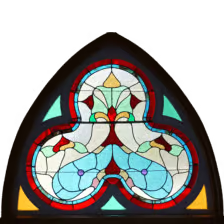Timeline of Our History
Compiled from Knox-Calvin’s Archives by: Meg Burrows and Mary Dickieson.
The earliest known reference to a Presbyterian Church in Harriston is found in the annual minutes of the Presbyterian Church of Canada for the year 1860-1861, although it is believed that a Minto congregation of Scottish settlers began to meet and worship together as early as 1857.
The Presbyterian Church was the first organized church that directed its clergy to come into this part of Ontario, and in 1861, George McLennan came to Harriston as a student missionary. He preached in school houses, cottages and barns in both English and Gaelic. His congregation included a number of Highland Scots and a smaller but influential faction with Lowland heritage. In 1864 a frame church was erected on land donated by the Harrison family, one of the pioneer families of the district, and Rev. McLennan was ordained and inducted into the Knox Church charge on Nov. 9.
Church records from the first decade of his ministry indicate the important role the church played in the lives of its members and the power it had to enforce moral standards in the community, sometimes withdrawing church privileges as retribution for acts of slander, theft and drunkenness. Musical instruments and hymns were considered sacrilegious. During a congregational debate over whether or not to purchase an organ, the Church records show in 1867: “We are perfectly satisfied with the Psalms of David and desire no other songs of praise. We would like to see all the hymns excluded and most of the paraphrases.”
1869 – The Minto congregation of 235 members spent a great deal of time in worship. The Sacrament Season, for example, began with a preparatory service on Friday, followed by another service Saturday morning. On Sunday, the congregation divided, with the Gaelic-speaking people worshipping in the Sunday School, while the English-speaking people worshipped upstairs. The whole season was brought to conclusion with a Thanksgiving service on Monday.
1870 – Some Knox members living in Clifford asked that Lyon’s School be designated as a “preaching station,” but session declined the request stating it was “extremely undesirable to grant the request of the Carrick people.”
1875 – The Lowland Scots were not as easily dismissed. When their request to eliminate Gaelic from Knox services was continually denied, a group broke away and established Guthrie Church as Harriston’s second Presbyterian congregation. They built their own church at an estimated cost of $12,000 and in 1889 negotiated a loan with The British Canadian Loan and Investment Co. at 6%, payable half yearly.
1877 – The Knox congregation laid the cornerstone of what is the present red brick building, with the entrance facing Raglan St. Windows were ordered from Stained Glass Works in Toronto; prices ranged from 60 cents to $2 per square foot. In the same year, Knox Church welcomed the members of Cotswold Church, who became part of the Harriston charge for a number of years and helped the congregation through a financial crisis created by the loss of those who formed Guthrie Church and made worse by starting construction on the new church building.
1883 – Church leaders agreed to take up a collection to aid the poor of the congregation.
1884 – The Knox congregation grew with the town population, reaching 308 members in full communion. Session encouraged all members to attend a temperance lecture held in August and delivered by the visiting Rev. Donald Fraser.
1887 – During Rev. M.C. Cameron’s ministry, the first W.M.S. was formed.
1899 – One church record indicates a pipe organ was installed, ending the need for a precentor to lead the singing of Psalms with a tuning fork. Nevertheless, the organ music was strenuously objected to by many of the charter members.
1908 –Session members tried to improve communication between themselves and the Board of Managers by requesting that letters be sent back and forth occasionally to “strengthen the bond of united effort in the work of the congregation.”
1910 –The Harriston church building was remodeled, moving the main entrance from Raglan St. to Elora St. and installing a ground-level vestibule.
1921 – Knox Church celebrated its Diamond Jubilee with Sunday services at 11 a.m. and 7 p.m., followed by a fowl supper that was attended by 700 people. The event drew twice the membership of the congregation, indicating support from the rest of the Harriston community and the important role the church played in the town. Records show Guthrie members transferring to Knox from 1919-1924, the first being Mr. and Mrs. H.E. Burrows and daughter Jean—May 20, 1919. “Gleanings from the Diamond Jubilee speakers: ‘A church may be too divine and too little human, or it may be the other way. What we need is the right balance – divine enough to be strong and enduring, and human enough to be active and useful. Most of the trouble is produced by those who don’t produce anything else.'”
1922 – Despite the success of the 60th Anniversary of Knox, Rev. Andrew J. Milligan used his annual message to admonish the congregation for poor attendance at weekly services: “In many of our homes there is an indifference manifest that bespeaks great worldliness. Those who have surrendered to the Christ-ideal of life do not neglect God in his house on the Lord’s Day. The Wednesday prayer service would be vastly more productive of spiritual power if more of our membership would keep the evening free for the hour of devotion.”
1923 – After 48 years of operation, Guthrie Church was closed. A contributing factor, no doubt, was the fact that Knox-Calvin had eliminated the Gaelic service in 1910. This had been the main reason for the establishment of the Guthrie congregation.
1924 – A Knox youth group known as the Tuxis Boys held devotional and literary meetings. Using the nickname “Hustlers,” the boys won the Harriston softball series. This year the Standfast class was first organized by Mrs. (Rev.) Small, with Miss Janet (Clark) Grice as its first president.
1926 – A beautiful communion table and oak chair were given to the church by Mr. and Mrs. Martin McEachern in memory of their son, Kenneth.
1927 – Frank Harrison became Sunday school superintendent and in his first year did not miss a single Sunday. Canadian Girls in Training (CGIT) had 15 members; the girls sold homemade candy and put on a play called “Serving of the Heathen.”
1928 – Gordon Harrison led 12 boys in the Trail Rangers Class, and the Board approved $170.10 be spent to repair the building’s landmark spire.
1929 – Costwold Home Helpers was established with 19 members. Meetings included regular devotions, but the business was primarily fundraising to benefit the church. In 1931 they raised $202.76 at a garden party attended by 600 people. Admission was 35 cents. Two girls’ baseball teams played as entertainment during the supper, and several church families – Darroch, McEachern, Harrison and Calder – put on a concert. The ladies’ group was active until 1954.
1930 – The Women’s Missionary Society (WMS), which was established about 1887, continued its work by raising money to outfit a girl of 11 years old in Formosa.
1931– The annual Session report addressed the country’s financial crisis: “There are times in the history of humanity when nothing is more disastrous than looking back; it turned Lot’s wife into a pillar of salt. Forward-looking men and women are more necessary today than ever before in the history of the Christian Church. The promise of old obtains for ever true: ‘As thy days so shall thy strength be.’ Let us all renew and replenish our strength by waiting on the Lord Omnipotent.”
1934 – Knox ran a deficit of $114.66; the mortgage on the manse stood at $1,000.
1935 – The church choir raised $45.61 by holding an Irish Tea.
1936 – Fifteen children were baptized, and Session purged the role of membership. 170 families made regular donations. The Ladies Aid Society boasted five groups of women who met regularly and contributed to missionary work at home and abroad.
1938 – WMS packed and sent away a splendid bale to aid the work of Rev. Fergusson of Mount Forest in China.
1941 – June 22 was Harriston Homecoming Sunday. Rev. William MacKay spoke at the Knox 80th Anniversary service; he was minister at Knox from 1908 to 1914.
1943 – General church receipts for the year were $3,373.38.
1945 – WMS Easter meeting included lantern slides on their work in British Guiana.
1947– Rev. Gordon Agar and his wife left Knox after four years to serve as missionaries in India. Rev. Andrew McMullen was called as the new minister.
1949 – Session Report: “All about us are opportunities for service if we have eyes for them. Ask yourself this question: ‘Am I an active member of Christ’s Church, or am I just among those present from time to time?’”
1950 – Knox created a committee of trustees to manage an estate gift of $9,082.93 from Mrs. Drusilla Fyfe; she was the widow of Albert Fyfe, who had been an elder of the church. At the beginning of the 1950s, the minister’s salary was $2,150, and it cost one cent to mail the annual report out to members of the congregation.
1951 – A project to rebuild the church organ was completed, and it was rededicated on June 17 by Rev. Wm. MacKay. The organist was Lois Beck. Over the next decade, the Knox congregation welcomed many new Canadian families from the Netherlands.
1960 – An addition was made to the church comprising the Mary and Martha room, the choir room and the vestry. This marked the end of long-term projects nicknamed Alice, Betty, Chloe, Dolores and Elaine that updated both the church and manse. In April, Rev. L.H. Fowler received an honorary degree from Knox College, and the Harriston congregation presented him with a study chair. He spent seven years in Harriston, leaving in January 1961 to accept a call in Aurora.
1961 – Knox celebrated its 100th anniversary. Rev. Gordon Agar, a former Knox minister, was the guest speaker for Youth Sunday Oct. 8. The Hon. Lt.-Col. John Keiller MacKay, Lt. Governor of Ontario, was a special guest Oct. 15, when the preacher was Rev. L.H. Fowler. Morning worship at 11 a.m. featured a duet by Sandra Crispin and Theresa MacDougall, “Do You Know.” At the evening worship, the soloist was Robert Smillie. Shirley Howes was the organist. The ladies of the congregation served a luncheon and hosted the annual fowl supper on Oct. 17.
1962 – Kirk Session reported this as one of the finest years in the history of the church with 413 names on the roll; including 48 people who joined that year. But even in the best year, there are missteps, including those by a group of teen girls who admitted that while helping with Sunday School, they sometimes slipped into Rev. Wilkie’s office during the service to drink coffee and smoke cigarettes.
1964 – In January, Knox hosted a Preaching Mission that included the Harriston and Clifford congregations. The audience was large on four nights of preaching.
1965 – The Boy Scouts held their annual parade in Knox Church in June, and the congregation again joined with the United Church for the summer months. The Dutch Reform congregation was meeting in the church on Wednesday evenings and had been doing so for several years. They donated $1,000 per year for using the building.
1967 – A service in October dedicated new furnishings in the sanctuary that included a Heintzman organ, carpeting, lights and a pulpit. Memorial windows in the sanctuary were installed and dedicated throughout the late 1960s and early 1970s as donations from members of the congregation in memory of loved ones.
1968 — Calvin Church Rothsay amalgamated with Knox Church Harriston to form Knox-Calvin Presbyterian Church. To mark the event, a service held on the afternoon of June 2 was taped for broadcast by the Kitchener television station in July.
1974 – The Sunday School and Youth Group began a 14-year relationship with Rajeshwari Miniraj, a young girl in India who was sponsored by the Knox-Calvin children until she completed pre-university classes.
1977 – Harriston Co-operative Nursery School was started in the church basement to provide pre-kindergarten training for 20 children each year. The last memorial window was installed and dedicated, the New English version of the Bible was placed in all church pews, and a Dec.18 luncheon was held to say good-bye to Rev. John Henderson and his wife, Dorothy, who left after six years in Harriston.
1979 – The Mary Burnett Memorial Nursery Fund was inaugurated, and the cradle made by Gordon Burnett was dedicated for use by newborn babies of our church. Many parents took advantage of the cradle.
1979 – A committee was formed to apply as sponsors for a refugee family. Norm and Flo Fry co-chaired the Vietnamese Family Committee, which raised more than $6,000 and collected donations of clothing and gifts to help the family become established in Canada. The Ta family arrived in January 1980 and moved into a home donated by Henk and Ricki Zemmelink. Later that year, the four adult members of the family secured employment in Toronto. Their Nov. 1 move was a momentous occasion for them and for the Knox-Calvin congregation as the Ta family became self-supporting and living together in a free country.
1981 – Knox-Calvin membership stood at 328 members in 174 households. A Young People’s group was formed under the direction of Roger Sisco and Derk Woestenenk.
1982 – These Days devotional booklets were ordered at a cost of 50 cents each. Vera Richardson, treasurer, reported the operating budget was $67,421.03.
1984 – The manse was sold by the congregation for $33,000 after considerable debate and as noted by clerk of session Ken Fisk, “Some disenchantment in the membership.”
1985 – A Knox-Calvin tradition for about 25 years, the Christmas Eve ceremony was well attended; the offering was $800.
1986 – Knox-Calvin celebrated its 125th Anniversary Oct. 19 with the Hon. Lincoln Alexander, Lt. Governor of Ontario, as special guest. A quilt made by Group IV was given to Alexander. A dinner and dance was held at the Legion. To commemorate the anniversary, a chair lift was added to the staircase in the sanctuary. There were 55 children in Sunday School.
1991– From the minister’s letter by Rev. George Bell: “The church with a purpose, however short of perfection it may ultimately turn out to be, has a vast advantage over a purposeless church, however wealthy it may be.”
1992– The Up Front Committee completed a building project to construct a new front entrance at a cost of $31,276.67. A number of fundraising events were held, including a talent auction that generated a great deal of interest and participation in the congregation. The building project also utilized a $10,000 loan from presbytery, which was fully repaid.
1993 – A new organ was purchased and installed. The “Wilkie window” – a “trefoil” window matching the one over the front entrance of the church – was repaired by Ken and Irene Fisk, donated to the church and installed at the back of the sanctuary.
1994 – The church record notes 12 deaths in the congregation, nine weddings and 13 baptisms. The Board reported it was struggling to keep ahead of the monthly bills, so members took turns cutting the grass. A yard sale, quilt draw and men’s supper were held to raise funds. The annual Standfast Class Valentine Luncheon returned $1,030.
1996 – Mary Lynn Woods replaced David Small as organist. Group IV quilted 15 quilts and sold three, earning $2,450. The congregation held numerous other fundraising activities, including a fish fry, lawn sale, and men’s supper. Rev. George Bell resigned in April after 16 years at Knox-Calvin; the pulpit was vacant from May 1996 to March 1998. Rev. James Goldsmith served as interim minister for six months before the congregation called Rev. Calvin Lewis.
1997 – Gordon Burnett built a scale model of the church and challenged the Sunday School children to “brick the church.” Their project still adorns the front entrance. Knox-Calvin joined the partnership of 13 church denominations in the Canadian Foodgrains project under the leadership of Derk Woestenenk and Henk Zemmelink. In the first year, the Harriston group raised 37.6 tonnes of corn and a cash donation of $4,129 – enough food to feed 1,500 people for a year.
1998 – The history room had its beginning when Grant MacKenzie asked to look into the preservation and microfilming of vital church records. In an effort to rejuvenate the Sunday School, a Space Mission Bible Camp was held during the summer.
1999 – The Lighthouse Group held a successful Easter breakfast and spaghetti dinner fundraiser and helped pick stones for the Foodgrains project. On Sept. 26, the Standfast Class celebrated its 75th anniversary.
2000 – Rev. Lewis led the congregation’s participation in Churches of Harriston History Day and an inter-denominational service of worship celebrating 2000 years since the birth of Christ. Colleen Robertson accepted the organist’s position after the resignation of Mary Lynn Woods. Through the efforts of David Howes, the Knox congregation dedicated a plaque honouring veterans of the First World War. Grant MacKenzie and June Macdonald were instrumental in organizing material from the Knox, Guthrie and Calvin churches and establishing a permanent history room. The congregation renovated the kitchen, painted the sanctuary and installed new carpeting. A successful fundraising auction was organized by Jim Zaryski, Brian Darroch and Larry Dickieson to support these projects.
2001 – Jackie Crispin retired as Sunday School superintendent, passing the job on to Ellen Weber; the children enjoyed a toboggan party at Minto Glen. An all-male choir performed on Mother’s Day, and the women of the church reciprocated on Father’s Day. Session helped Kristin Foran, Kyle Mallett and Heather McAllister attend the Triennium 2001 at Purdue University and assisted Katie Dickieson in her Youth in Mission venture in Eastern Europe.
2002 – Sylvia Poole retired as secretary-treasurer after almost 14 years of service. New hymnals and psalters were purchased; Group IV donated the money for ten sets of books. The combined efforts of the Harriston churches sent $22,000 in donations to the Canadian Foodgrains.
2003 – During Harriston’s 125th-anniversary celebration, organist Colleen Robertson led a mass choir at the ecumenical service held in the arena. The church installed a plaque above the cornerstone of its building acknowledging the building dedication on June 27, 1877.
2004 – A new sound system was installed in the sanctuary, funded by donations.
2005 – This was a difficult year in the life of the church because of a theft, but the congregation continued its Christian mission through the Canadian Foodgrains project and other local and global efforts. After serving in an interim capacity, Art Foran accepted both secretary and treasurer duties full-time.
2006 – Early in the year, Rev. Lewis resigned and Dr. Ken Fisk retired as clerk of session after many years of service. Rev. Kees Vandermey served as interim moderator and congratulated Knox-Calvin on its work in the community, its commitment to Canadian Foodgrains and the congregation’s history room. Session supported Meg Burrows’ mission trip to Romania. Over the next five years, the congregation would also support and encourage members Henk and Ricki Zemmelink and Iris Richardson who donated their time to help with building projects at orphanages in the Dominican Republic and in Haiti, and Dr. Terry Fisk, who used his veterinary skills to benefit Inuit villages in Canada’s north.
2007 – Rev. Dennis Wright and his wife, Diana, became part of the Knox-Calvin congregation in July, Harriston being his first pastoral charge. In his first annual message, he said: “We must find new ways of communicating the Good News of the Gospel to the present generation and future generations…so that Christianity will remain relevant in people’s lives; that Christ remains the Lord of all.
2008 – At the annual meeting, Sunday services were moved permanently to 10:30 a.m., and clerk of session Iris Richardson commended many people who contribute to the life of the church, including the ladies groups whom she called the “EverReady Bunnies.” A projector and screen were added to the sanctuary to project songs, scripture and coming events. Knox-Calvin hosted the ordination of Scott McAllister on Sept. 14; Session had supported his nomination to Knox College. He attended Knox-Calvin as a child, was an active member of the youth group and performed in the church many times in a singing trio with his siblings Heather and Mark. His ordination was the first such event in the church since Rev. George McLennan was ordained in 1864.
2009 – The traditional Christmas Eve services were reduced to one service at 8 p.m. and a church library was established.
2010 – Rev. Dennis Wright resigned his position after accepting a call to Aurora, Ont. The Knox-Calvin congregation began preparations for its 150th anniversary in 2011. Greeting cards that feature the stained glass windows were produced and sold to help fund restoration of the windows as a 150th project.
2011 – In its 150th-anniversary year, the Knox-Calvin pulpit was vacant, but the congregation was blessed by the services of many guest ministers and speakers. Stained glass windows on the south side of the church were restored by Robert McCausland Ltd. at a cost of $23,730.00, funded by generous donations and fundraising events.
Group IV disbanded in 2011, but the ladies planned to continue their fellowship of quilting. In their last year of operation, Group IV purchased a defibrillator for the church.
2012 – We opened a new chapter in the life of Knox-Calvin January 08, 2012 with the induction of Rev. Kathy Morden to our congregation.
The Friendship Room was renovated and furnished with help from the Standfast Class.
2013 – The annual report of Knox-Calvin reveals an unremarkable year in the life of the church, yet a remarkable number of ongoing mission and outreach projects:
- the church co-hosted a fundraising event to benefit Africa Arise, an international charity founded by Harriston native Tricia Deboer;
- cards, letters and treats were sent to Knox Calvin youth who were attending post-secondary institutions;
- a Valentine Lunch, fish fry, fall supper and Christmas Bazaar welcomed the Harriston community to our church building;
- several members went bowling and fundraising for Big Brothers;
- 16 people were remembered with flowers or a fruit basket;
- 24 Christmas “cheer” boxes were assembled and delivered to shut-ins;
- individual donations of food and toiletries helped to supply the Harriston Food Bank;
- financial help was provided for a church member injured in an accident;
- 65 prayer shawls were knit and given to those in our community who were ill or lost a loved one;
- $21,000 raised for the Canadian Foodgrains Bank through a community growing project, plus an additional $44,459 was raised at a special “Antique Extravaganza” organized with help from Knox Calvin members to mark the 30th anniversary of the Foodgrains organization.
And this was simply a typical year for the Knox-Calvin congregation.
2014 – Knox-Calvin hosted a spring ecumenical service at the Drew Community Centre, asking attendees to “drive a tractor to church” as a way to celebrate farming and rural life. Later in the year, the Kirk Session moved from lifetime membership to term-service memberships. Elders are now elected for six-year terms, with elections held every two years. Session members can be re-elected or choose the option of stepping down at the end of their terms.

2015 – About a dozen Knox-Calvin members played key roles in the establishment of a Minto Refugee Settlement Committee to sponsor a Syrian refugee family. The eight-member Almohamad family arrived in Harriston in October 2016 to begin their new life in Canada. The family settled in quickly with English lessons, the children in school and a local job for father Ahmad.
2017 – Knox-Calvin published a new church photo directory, with 172 adults and children listed.
2018 – This year, the Harriston Foodgrains Project donated $35,000 to the Canadian Foodgrains Bank. Knox-Calvin had partnered with the Harriston United Church about 30 years ago to begin a Foodgrains growing project in this area. It is supported by church members who buy shares to help cover input costs. The Henk Zemmelink family has organized the work of planting and harvesting the crop for several years, and Jim and June Macdonald have donated their land since 2007. Since 2014 the project has also received an annual gift from Toronto’s Royal York Road United Church.
2019 – At the annual meeting in February, the Board of Managers reported a $32,000 difference between income and expenses in 2018. As this widening gap was indicative of a multi-year trend, the congregation took several measures to improve financial security. A one-year Stewardship Committee was established to advocate for greater giving, resulting in a 15% increase in 2019. Also in 2019, Rev. Morden dropped back to a three-quarter-time ministry.
Sadly, the Standfast Class disbanded at the end of the year after 95 years of service to the church. This ladies group was recognized for the community outreach and fellowship they provided over the years and for their huge financial contributions to the church.
2020 – When the Province of Ontario enacted a pandemic shutdown order on March 17, 2020, Knox-Calvin canceled in-person services and activities to protect the congregation from the COVID-19 virus. Rev. Morden provided Sunday services via email. Despite a short reprieve in the fall when pandemic precautions were used – masks, hand sanitizer and social distancing – the Knox-Calvin congregation worshiped and socialized online throughout 2020.
Knox-Calvin’s Stained Glass Windows
The windows of our church not only enhance the beauty of the sanctuary, but also speak to us and those who follow after us of the faith we hold. They constantly remind us of the devotion and sacrifices made by those who came before us and worshipped here at Knox-Calvin.
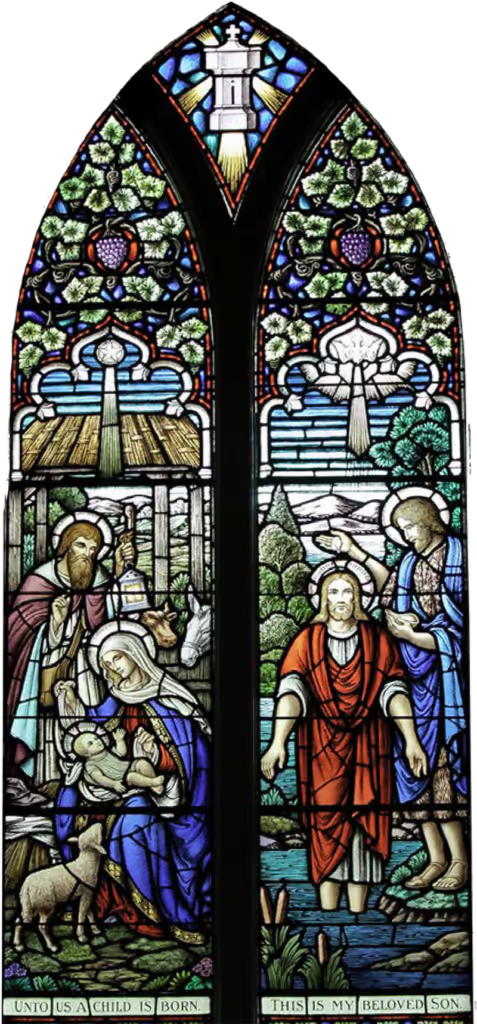
This is My Beloved Son

I Am the Light of the World
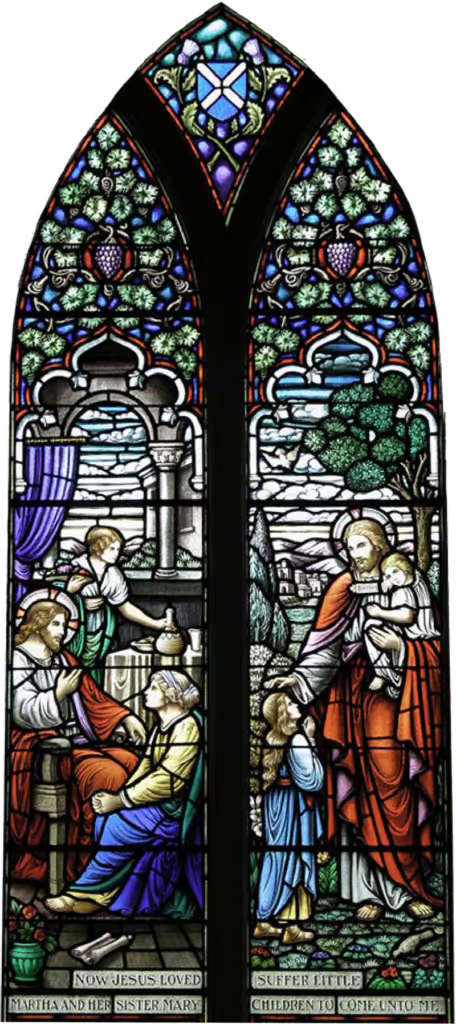
Suffer the Little Children to Come Unto Me
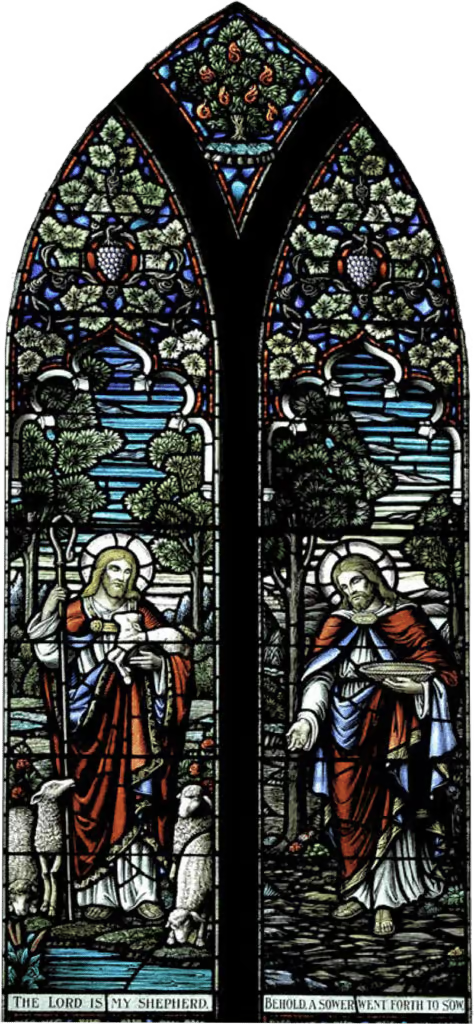
Behold, a Sower Went Forth to Sow
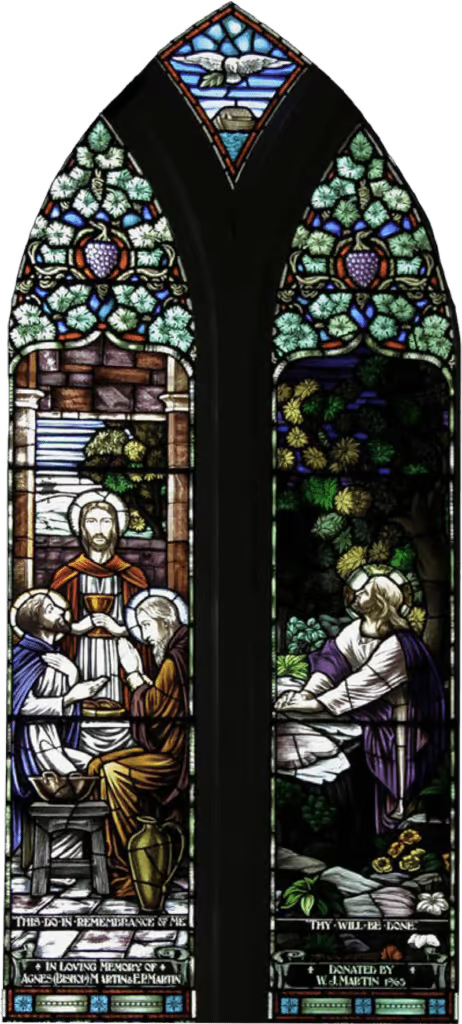
Thy Will Be Done
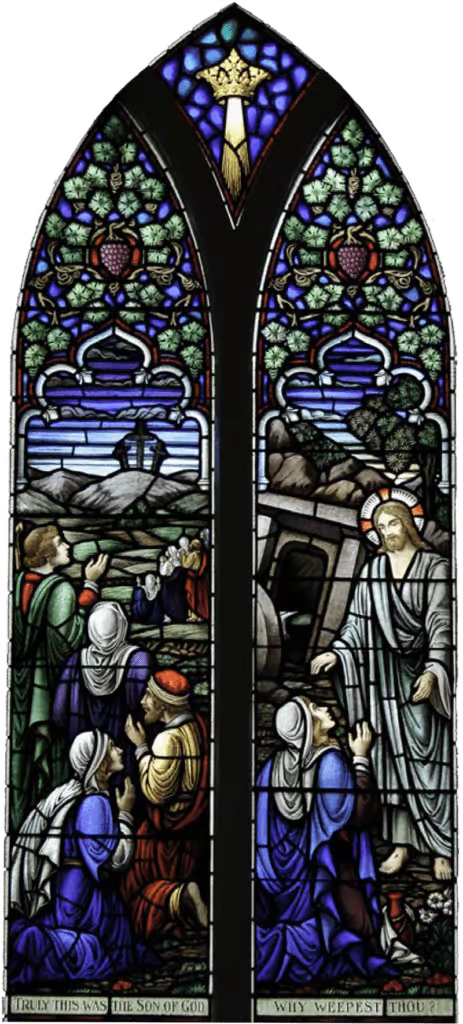
Why Weepest Thou?
The stained glass windows placed as memorials to loved ones depict the life and work of Christ. Beginning with His birth and baptism, they follow through the whole of His ministry and include the feeding of the five thousand, all of the miracles and Holman Hunt’s well-loved picture, The Light of The World. One set of windows presents Christ’s ministry to women, and one to that of children. On the south side of the church is Christ as The Good Shepherd, then the Parable of The Sower, representing all of the parables Christ told. The next set brings us closer to the end of His ministry with The Last Supper and, finally, the Crucifixion and Resurrection.
These windows were donated by W.J. Martin in 1965; Janet and Percy Dryden, the family of Jennie McAndless, William Clark Chambers and Nelson Morrell Thomson, all in 1967; Frances MacKenzie Martin in 1969; and Jessie Ella Lambe Westgate in 1970.

The hinged window at the front of the sanctuary depicts the burning bush from Exodus 3:1-5. This beautiful window, a reminder of God’s steadfast love, was donated by Archie McCready in 1975.
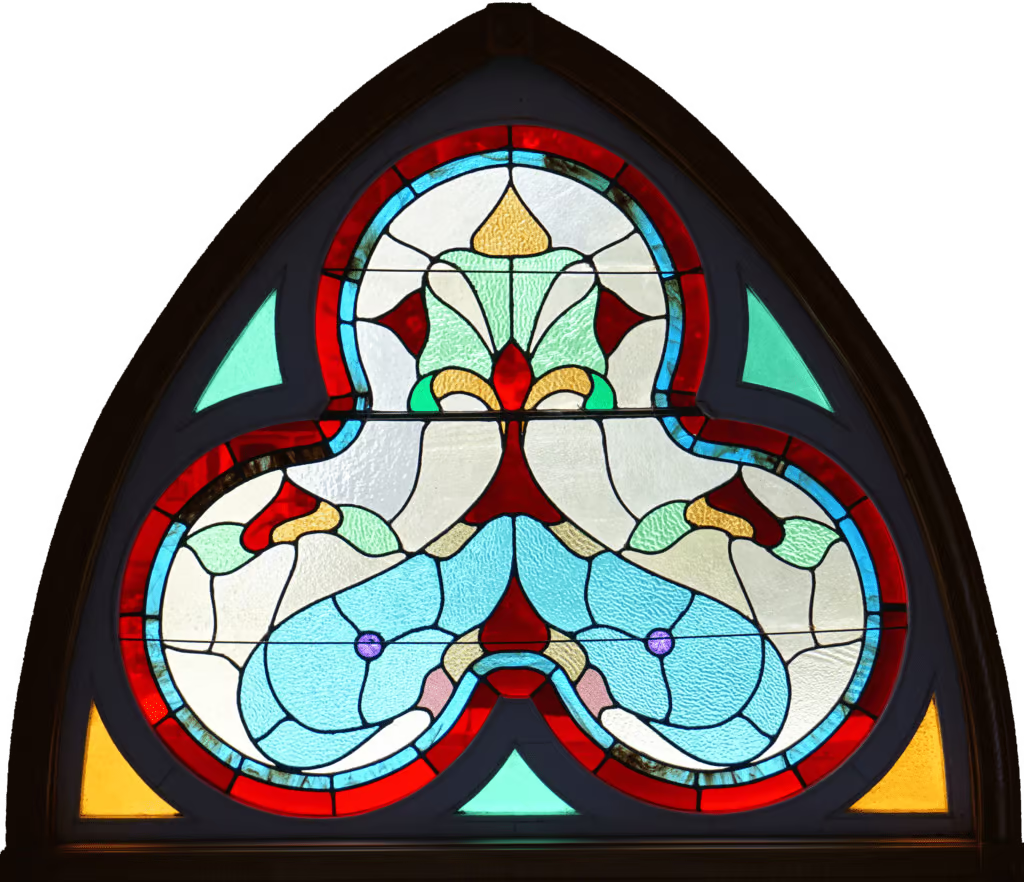
The Ministers of Knox-Calvin
Rev. George McLennan (1865 – 1875)
Rev. John McIntyre (1875 – 1878)
Rev. John Campbell (1878 – 1887)
Rev. Malcom C. Cameron (1887 – 1908)
Rev. W.H. MacKay (1908 – 1914)
Rev. George Mason (1914 – 1918)
Rev. Andrew J. Milliken (1918 – 1924)
Rev. J.S. Small (1924 – 1925)
Rev. R.B. Ledingham (1925 – 1931)
Rev. Parry D. Jones (1931 – 1933)
Rev. Lewis Williams (1933 – 1939)
Rev. George Aitkin (1939 – 1943)
Rev. Gordon Agar (1943 – 1947)
Rev. Andrew J. McMullen (1947 – 1953)
Rev. Louis Fowler (1953 – 1961)
Rev. J.D. Wilkie (1961 – 1971)
Rev. John Henderson (1971 – 1977)
Rev. George Bell (1979 – 1996)
Rev. Calvin Lewis (1998 – 2006)
Rev. Dennis D. Wright (2007 – 2010)
Rev. Kathy D. Morden (2012 – )
The Organists of Knox-Calvin
Mary Wilson (1908 – 1910)
F.G. Moore (1911 – 1912)
T.W. Wilmott (1913)
Hazel Weatherwax (1914 – 1919)
Mrs. Mulheron (1920 – 1921)
Hazel Sinclair (Weatherwax) (1922 – 1933)
Mrs J.M. Moore (1934 – 1936)
Hazel Sinclair (1937 – 1938)
Dorothy Blacker (1939 – 1940)
Mrs George Gebhardt (1941)
Hazel Sinclair (1942 – 1948)
Mr. Gay (1949)
Hazel Sinclair (1950)
Lois Beck (1950 – 1952)
Lois Beck (Ottewell) (1953)
Auldine Melville (1953 – 1954)
Mrs L. Charters (1954)
Rondell Klinck (1955 – 1957)
C.A. Howey (1958 – 1961)
Mrs Shirley Howes (1962 – 1964)
Joan Park
Mrs Marie Andrews (1965 – 1970)
Mrs Reta Robb (1971 – 1976)
Susan Ahrens (1977 – 1978)
Mrs Reta Robb
Susan Ahrens (1979 – 1982)
Mrs Shirley Howes (1983 – 1984)
Reta Robb
Mrs Shirley Howes (1985 – 1992)
Mrs Shirley Howes (1992)
Trent Stanley
David Small (1993 – 1995)
Mary Lynn Woods (1996 – 2001)
Colleen Robertson (2001 – 2014)
April Martin (2014 – 2019)
Connie MacEwan (2019 – 2020)
Standfast Class
The Standfast Class was originally a young men’s and women’s Bible class, meeting each Sunday. Mrs. (Rev.) Small organized the class of over 50 members in 1924. Mrs. Small was its first leader and Miss Janet Clark its first president.
The class soon lost its masculine touch and became a ladies evening class meeting every first and third Monday of the month. The second leader was Miss Edith Sinclair, later known as Mrs. (Rev.) Coulter, who assumed the role in early 1926.
In July 1926, the class had a very successful garden party; the proceeds of baking sales were given to the Ladies Aid and the church.
Mrs. Dinniwell became the next leader from 1931 to 1935, followed by Mrs. Sanderson in 1936. The next leader was Mrs. Finlayson, who organized a number of plays, one being “Anne of Green Gables.” Bonnie McCready played Anne, and Ken MacKenzie was Gilbert.
Over the years, the Standfast Class has catered to funeral luncheons, weddings, wedding anniversaries, an annual soup and sandwich luncheon and Hardy-Lee Funeral Home memorial services. Money earned through these efforts has been donated to numerous church and outreach projects: the hospital fund, our local Foodgrains project, people doing mission work, and other personal donations. The Class has purchased for the church two electric stoves, a dishwasher, a sign for the front lawn, chairs and tables, and serving dishes: white plates, cups, saucers and soup bowls.
Standfast donations bought furniture for the Friendship Room, helped to repair the stained glass windows in the sanctuary, and funded numerous renovations over the years. For the last five years, the group has paid the church fuel bill for January, February and March.
Among living members of the Standfast Class, Irene Fisk and Mary Stoddart have the most years of service; Mary has been active right to the group’s closure in 2019.
We are sorry to close down the Class, but there are only four active members left. We have enjoyed working for the church and have had a lot of good times together.
Signed on behalf of all Standfast Class members,
Mary Stoddart, Lois Kerr, Pat Reading and Doreen Harkness
